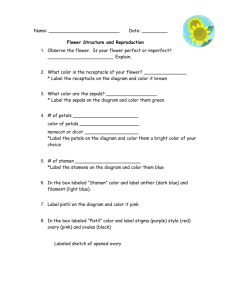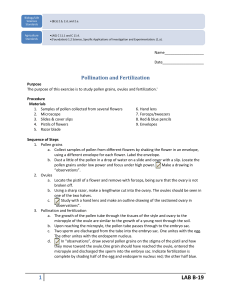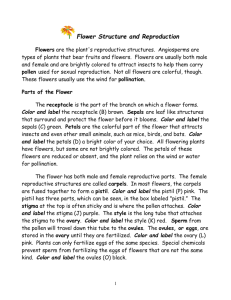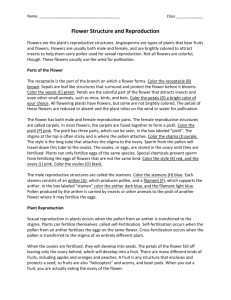"pdf" copy of Topic 27
advertisement
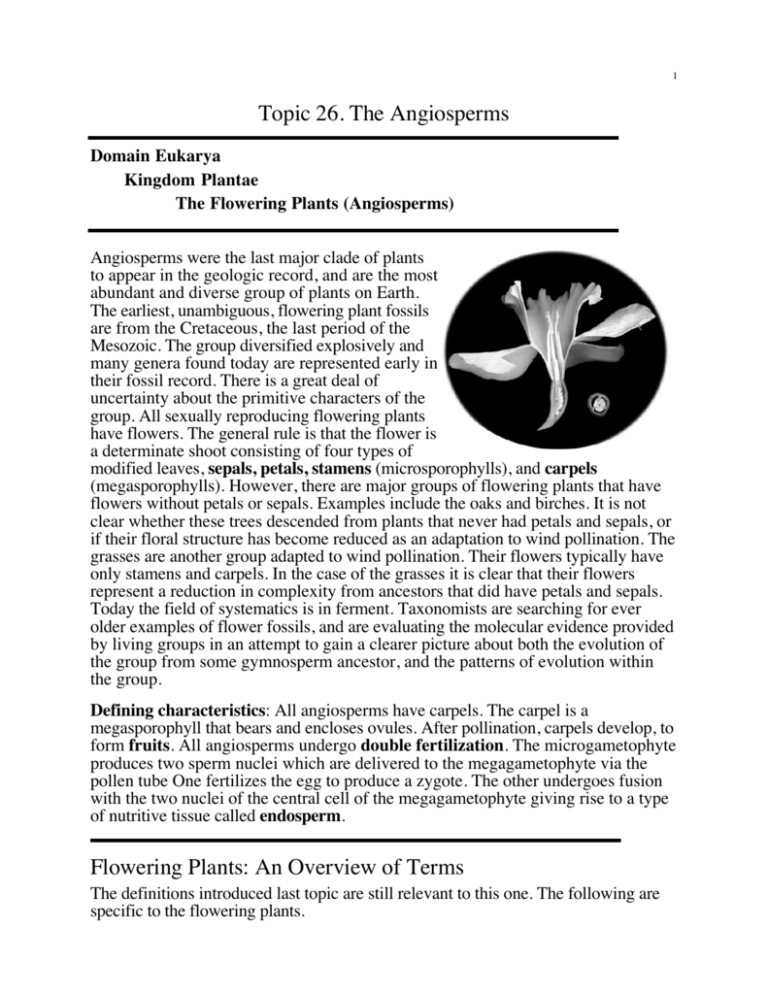
1 Topic 26. The Angiosperms Domain Eukarya Kingdom Plantae The Flowering Plants (Angiosperms) Angiosperms were the last major clade of plants to appear in the geologic record, and are the most abundant and diverse group of plants on Earth. The earliest, unambiguous, flowering plant fossils are from the Cretaceous, the last period of the Mesozoic. The group diversified explosively and many genera found today are represented early in their fossil record. There is a great deal of uncertainty about the primitive characters of the group. All sexually reproducing flowering plants have flowers. The general rule is that the flower is a determinate shoot consisting of four types of modified leaves, sepals, petals, stamens (microsporophylls), and carpels (megasporophylls). However, there are major groups of flowering plants that have flowers without petals or sepals. Examples include the oaks and birches. It is not clear whether these trees descended from plants that never had petals and sepals, or if their floral structure has become reduced as an adaptation to wind pollination. The grasses are another group adapted to wind pollination. Their flowers typically have only stamens and carpels. In the case of the grasses it is clear that their flowers represent a reduction in complexity from ancestors that did have petals and sepals. Today the field of systematics is in ferment. Taxonomists are searching for ever older examples of flower fossils, and are evaluating the molecular evidence provided by living groups in an attempt to gain a clearer picture about both the evolution of the group from some gymnosperm ancestor, and the patterns of evolution within the group. Defining characteristics: All angiosperms have carpels. The carpel is a megasporophyll that bears and encloses ovules. After pollination, carpels develop, to form fruits. All angiosperms undergo double fertilization. The microgametophyte produces two sperm nuclei which are delivered to the megagametophyte via the pollen tube One fertilizes the egg to produce a zygote. The other undergoes fusion with the two nuclei of the central cell of the megagametophyte giving rise to a type of nutritive tissue called endosperm. Flowering Plants: An Overview of Terms The definitions introduced last topic are still relevant to this one. The following are specific to the flowering plants. 2 Flower: A determinately growthed shoot that typically includes four tiers of modified leaves: The calyx made up of sepals, the corolla made up of petals, the androecium made up of stamens, and the gynecium made up of carpels. Complete vs Incomplete: A flower is complete if it contains all four tiers of modified leaves. A flower is incomplete if it does not have all four tiers of modified leaves. Perfect vs Imperfect: A flower is perfect if it is bisexual having both functional carpels and stamens. It is imperfect if it does not. Monoecious vs. Dioecious: If a plant has imperfect flowers, but both male and female flowers are borne on the same plant, it is monoecious. If a plant has imperfect flowers, but male flowers are borne on one plant, and female flowers are borne on another, it is dioecious. Receptacle: The central axis of the flower. Sepals: Modified leaves which are whorled. These are inserted below the petals and may or may not be showy. Together these make up the calyx. Petals: Modified leaves which are whorled. These are inserted above the sepals and are usually showy. Together these make up the corolla. Stamens: Are the microsporophylls of flowering plants. Anthers: Are the microsporangia of flowering plants borne on the stamens. Filaments: Are the part of the stamens that support the anthers. Carpels: Are the megasporophylls of flowering plants. These enclose the ovules, and the base containing the ovules matures into a fruit. Pistil: Consists of one or more carpels, and consists of an ovary, stigma and style. 3 Ovary: Is the base of the pistil which contains the ovules and which matures into a fruit. To the right is a cross section of a compound ovary of lily made up of three carpels. Each carpel encloses a space called a locule. Stigma: The tip of the pistil where pollination occurs. Style: The part of the pistil between the ovary and the stigma. Ovule: Before fertilization ovules are like that of other seed plants including integuments, a nucellus and a megagametophyte. After fertilization, the megagametophyte is replaced by endosperm. Embryo Sac: The megagametophyte of an angiosperm. This is greatly reduced and is an 8-nucleated 7-celled structure that includes an egg, two synergid cells bordering the egg; a large binucleated central cell, and three antipodal cells opposite the egg. Double fertilization: In angiosperms, pollination results both in the fertilization of the egg to form a zygote, and also of the central cell to form a primary endosperm nucleus. Endosperm: The tissue resulting from the fertilization of a sperm nucleus with the central cell. As the central cell is binucleated, this tissue typically is triploid. All angiosperms form endosperm, but many mature seeds lack endosperm as it is consumed during seed development. In these plants, the function of food storage is taken over by cotyledons which are leaves of the embryo. Pollen grain: In angiosperms, the microgametophyte is reduced to two cells: the tube cell and the generative cell. The generative cell divides to form the two sperm nuclei. Fruits: These enclose the mature seeds and are derived from the ovary of the pistil. These may be fleshy, or hard. If hard they may be dehiscent or indehiscent. Aggregate fruits: Are formed from flowers with multiple pistils. Each pistil matures into a separate fruitlet and the whole is united by the receptacle of a single flower. Multiple fruits: Are formed from many flowers where the ovaries of different flowers meld together to form the fruit. 4 I. Complete Flowers Ia. Magnolia Flower. Take a bowl with a dissected Magnolia flower from the front desk to your seat. To aid you in this study, your TA has a picture of the flower in its living form displayed on the teaching monitors. The central axis of the flower is termed the receptacle. The receptacle bears four types of modified leaves. At the base of the flower occur two whorls of petal-like structures. The lowest whorl is termed the calyx. The individual members of the calyx are the sepals. The next whorl up is termed the corolla and its individual members are the petals. Above the petals are born the stamens which together make up the andreocium. Note that these are not whorled but spiralled around the receptacle. To see this pattern study the scars on the receptacle where the stamens were detached. This arrangement is considered a primitive characteristic in flowers. Take a detached stamen and observe it using a dissecting microscope. Note the pollen bearing sacs termed the anthers. These are microsporangia and the stamen is a microsporophyll. Also note the stalk below the anthers that attach the stamen to the receptacle. This is the filament of the stamen. Draw the stamen of Magnolia - label anthers and filament. The Gyneocium: The structures above the andreocium are carpels which together make up the gyneocium. Like the stamens these are also spiralled around the receptacle. The carpels in Magnolia each represent a single pistil. Pistils are made up of one or more carpels. Each pistil includes three parts. The base where the ovules are contained, is termed the ovary. The tip where pollination occurs is termed the stigma, and the part between the two is termed the style. Because the pistils are positioned above the other three parts of the flower (calyx, corolla, and andreocium) they are termed superior. Observe the non-dissected flower at the front. Note that these flowers are radially symmetrical. Magnolia does not produce nectar. What other reward might lure pollinators to the flower? ___________________________________________________________ __________________________________________________________________ 5 Based on your observations of the structure of the flower, does Magnolia limit access to any potential pollinator? _______________________________________ __________________________________________________________________ Label the figure: A = __________________ B = __________________ C = __________________ D = __________________ E = __________________ Ib. The Cherry Flower (Prunus). Pluck a flower from a preserved inflorescence. Be careful as the petals tend to become detached. Using a dissecting microscope, observe an intact flower. Note that the flower is radially symmetrical. Which floral parts are fused? __________________________________________________________________________________________ __________________________________________________________________ __________________________________________________________________ The floral cup you see is a character shared by members of the rose family (Rosaceae), and is called a hypanthium. What floral parts are fused to form the hypanthium? ________________________ _________________________________________________________________ 6 How many pistils are there on each flower? _________ Is the ovary inferior or superior? _____________ When alive, the flowers are white with a strong scent and produce nectar, What, do you suppose, pollinates these flowers? _________________________________ Black cherry is in the genus, Prunus. This large genus includes cherries, plums, peaches, and almonds. All have flowers similar to black cherry. Ic. The Snapdragon Flower (Antirrhinum). We have plenty of material and you should dissect two flowers. First Dissection Observe an intact flower. Note that the flower is bilaterally symmetrical. 7 Which floral parts are fused? _______________________________________ __________________________________________________________________ Grasp the corolla and gently pull it off the flower. The pistil should be clearly visible. Is the pistil superior or inferior? _______________________________________ Take the corolla tube and cut a slit through its side. Lay the tissue flat in a single layer. Note that the stamens are fused to the corolla. The Pistil. Observe the pistil and make a drawing - label ovary, style and stigma. Make a cross section of the ovary and mount on a glass slide. Use a dissecting microscope to study the internal details. The openings in the ovary enclosed by the carpels are called locules. - Identify the ovules inside the locules. Often there is a locule for every carpel in a compound pistil (remember the ovary is part of the pistil). Observe where the ovules are attached to the wall of the ovary. - This tissue is termed the placenta. Draw a cross section of the ovary. Label each carpel, the placenta, and the ovules. 8 Snapdragon flower - Second Dissection This time slice the flower in two using a sharp razor blade exactly along the plane of symmetry. Label the diagram below. A = _____________ B = _____________ C = _____________ D = _____________ E = _____________ Overview: The snapdragon flower has characters considered to be less primitive than those of Magnolia. These are outlined below: Fused floral parts: - The petals are fused - The stamens are fused to the corolla - The sepals are fused - The carpels are fused to form a compound pistil. The parts of the flower (calyx, corolla, andreocium) are arranged in whorls (unlike Magnolia none of the parts are spirally arranged). The flower is bilaterally symmetrical Evolution in the flowering plants is often driven by the need to get pollen from one flower to another of the same species. 9 How is the snapdragon flower adapted to this task? ________________________ _________________________________________________________________ _________________________________________________________________ _________________________________________________________________ _________________________________________________________________ Why might it be maladaptive to allow easy access to the nectar of the flower to all comers? ________________________ _________________________________________________________________ _________________________________________________________________ _________________________________________________________________ _________________________________________________________________ Id. The Fuchsia Flower. We have one flower for each student. Before dissecting observe the intact flower. What is the symmetry of the flower? ____________________________ Which parts seem to be fused? ____________________________ Is the ovary superior or inferior. ____________________________ Dissecting the Fuchsia Flower Carefully slice the flower in two longitudinally. Start with the ovary and work your way up one side and then up the other. Lay the two halves of the flower with the cut surfaces facing up. 10 Which parts are fused? ____________________________ Draw this dissected flower. Label the following parts: pistil, stigma, style, ovary, sepals, petals, stamen, anther, filament. Based on your observations of the flower what pollinates this plant? ____________________________________________ Ie. Dandelion (Taraxacum) Flowers. Dandelion belongs to the composite family (Asteraceae) that includes daisies, asters, sunflowers and dahlias. These all bear small flowers in a tight inflorescence considered by most people do be the individual flowers. Take a head of flowers to your bench and share flowers with your table partners (use one head per bench). Observe flowers with a dissecting microscope. While viewing with a dissecting microscope, observe an intact flower. Note that the flower is bilaterally symmetrical. Which floral parts are fused? _________________________________ Is the ovary inferior or superior? ____________________________ What, do you suppose, pollinates these flowers? __________________ What floral part is represented by the hairs below the corolla? _____________ 11 Draw a flower. Label anther, stigma, corolla, calyx and ovary. II. Incomplete Flowers. Complete vs. Incomplete: Magnolia, snapdragon and Fuchsia flowers all have the four basic parts of a generic flower: calyx, corolla, andreocium, and gyneocium. Flowers with all three are termed complete. Flowers missing one or more of these parts are termed incomplete. IIa. Sugar Maple: Take a flower of sugar maple to your seat and dissect it while observing through a dissecting microscope. Note that it is incomplete as it has no petals. These flowers are wind pollinated. In sugar maple, each flower has both pistils and stamens, but each flower is functionally either male or female as either the stamens or the pistil are underdeveloped. IIb. Perfect vs. Imperfect: Flowers with both pistils and stamens are perfect. Some flowers have either stamens or pistils. These flowers are termed imperfect. All imperfect flowers are also incomplete. Observe examples on the side bench. Corn: Corn (Zea mays) is in the grass family (Poaceae). Like other members of this family the flowers have neither petals or sepals. Corn also has imperfect flowers. Female flowers are clustered in the axils of the leaves along a cob. Male flowers are formed on the top of the plant. What floral part do you suppose are the silks of the corn cob? ___________ 12 Begonia: Observe the flowering Begonia plant on the side bench. Note that on the same plant are found flowers either with stamens or with a prominently ribbed, inferior ovary. Begonia has imperfect flowers. Oak: Oak (Quercus) flower in the spring. Male flowers are clustered in dangling inflorescences. Female flowers are borne in the axils of the leaves. IIc. Monoecious vs Dioecious: Plants with imperfect flowers that have both male and female flowers on the same plant. like Begonia and corn, are termed monoecious. Plants that have only male flowers or female flowers are termed dioecious. Salix: Observe the herbarium specimens of willow. Note that one has male flowers while the other has female flowers. Salix is a dioecious species. III. The Lily Life Cycle 13 IIIa. The lily flower. Observe the intact and partially dissected lily flowers on the side bench. Are lily flowers bilaterally or radially symmetrical? ____________________________ Are the flowers perfect or imperfect (one flower has had the stamens removed)? _____________________________________________ Are the flowers complete or incomplete? ___________________________ Is the ovary superior or inferior? ____________________________ IIIb. The Young Lily Bud. Take the prepared slide in your box labelled “Lilium: Pollen Tetrad” and hold it up to the light. Study it with your unaided eye. Note that this is a section of an unopened flower bud. At the stage the slide was made the anthers were in the same plane of section as the ovary. The Immature Anthers Observe the anthers in this section. Note that they contain tetrads of microspores (note the slide label is incorrect). Also note the innermost tissue layer. This is the tapetum and it is important in the development of the pollen grains. It is consumed as the anther matures. Draw an anther in cross section: label microspores and tapetum. 14 The Immature Ovary Using the same slide as before, observe the ovary at 40x. How many carpels make up this pistil? _________________________ Observe the placenta with attached ovules. Note the huge cells inside each ovule. These are the megasporocytes (megaspore mother cells). These cells reside in the nucellus (megasporangium). Note that there are two integuments and that they are incomplete. After pollination they will grow to encase the ovule. Label the figure. A= A= B= B= C= IIc. The Immature Embryo Sac (megagametophyte). Take the prepared slide labelled “Lily Ovary” and observe it using your unaided eye. Verify that there are cross sections through a lily ovary on the slide. The three locules should be clearly visible in some of these sections. Observe the slide with your microscope. The four nucleated cell in the ovule is the embryo sac (the megagametophyte) at the four nucleated stage of development. Also identify the nucellus and the integuments. 15 Draw an ovule: label embryo sac, nucellus and integuments. IIId. The Mature Embryo Sac. Observe the prepared slide of the mature embryo sac on the side bench. This megagametophyte consists of only seven cells and eight nuclei. It will be destroyed by double fertilization but this will result in the formation of two genetically distinct cells, the primary endosperm cell and the zygote. The three cells opposite the micropyle are the antipodals (A). These seemingly have no function. In the center of the embryo sac is a huge binucleated cell, the central cell (B). This will undergo fertilization with one sperm nucleus resulting in triple fusion of all three nuclei. The three cells closest to the micropyle are called the egg apparatus. One of these cells will undergo fertilization with one sperm nucleus resulting in a zygote. The other two will act as synergids and will be destroyed by the pollination tube. IIIe. Dehiscing Anthers. Take the slide labelled “Lilium Mature Anthers” and study it with your unaided eye. Observe that this is a section made through an open lily flower where the anther is at the level of the style. Note the section of the style in the center surrounded by the anthers. Observe the slide with your microscope. Note the pollen grains (immature microgametophytes) inside each anther and the absence of the tapetal layer. 16 The Pollen Grain Observe the pollen grains at 400x. The microgametophyte consists of a tube cell (A points to the nucleus of the tube cell) with a generative cell inside it (B). The tube cell germinates to produce the pollen tube. The generative cell undergoes mitosis to produce two sperm nuclei that are delivered to the mature embryo sac. IIIf. Pollen Germination. After a pollen grain lands on the stigma, a pollen tube emerges from the walls of the grain and into the style. As the pollen tube grows through the style the generative cell moves into the tube and undergoes mitosis to produce two sperm nuclei. Pollen germination can be observed by placing pollen grains into a dilute sucrose solution. This requires some patience. Work in pairs. Place a drop of dilute sucrose solution on a glass slide. Rub the nose of an Impatiens flower into this drop and prepare a wet mount with a cover slip. Draw a pollen grain before germination. Place a drop of water along the edge of the cover slip to prevent the slide from drying. View your slide periodically over the next 20 minutes to discern when germination begins. Again keep adding a drop of water to the edge of the slide to prevent drying as needed. After germination make a second drawing of the grain with the associated pollen tube. Look for the generative cell though it may be hard to see. Ungerminated Pollen Grain Grain with Pollen Tube 17 IIIg. Double Fertilization. Observe the demonstration slide of double fertilization on the side bench.This is a difficult slide and may require through focusing. In the photomicrograph the right the two sperm nuclei are identified. The one to the right is undergoing karyogamy with the egg nucleus to form the zygote. The one to the left is undergoing karyogamy with the two polar nuclei to form the primary endosperm nucleus. IV. Fruits. Pistils are made of carpels which are a type of megasporophyll. The part of the pistil containing the ovules is the ovary. Fruits are ripened ovaries. One of the definitive characters of the angiosperms is that the ovules are encased. Fruits always serve to protect the maturing ovules/seeds. However, a great deal of variation exists in the angiosperms in regards to the nature of the mature fruit. IVa. Berries: Some fruits become totally fleshy. These fruits are berries. Many unrelated plants have fruits that are berries. In regards to fruit-type a great deal of convergent evolution has occurred. Observe the demonstration of berries at the front bench. For each listed in the table below, answer the following questions. How many carpels are represented? How many locules are represented? 18 Number of Carpels Number of Locules Grapefruit Kiwi Fruit Tomato Winter Squash Banana Notes: What selective pressure drives the evolution of berries? _____________________________________________________________ _____________________________________________________________ IVb. Drupes: Fruits that have a fleshy outer and a stony inner part are drupes. “Stone fruits” are drupes, and include cherries, peaches, plums, apricots and nectarines. All are members of the genus Prunus in the family Rosaceae. Other plants bear drupes as well but are unrelated.. This is another example of convergent evolution. Observe the demonstration of drupes at the front bench, and study the illustrated peach fruit below: 19 Why isn’t an avocado a drupe? __________________________________ ______________________________________________________________ What environmental factor drives the evolution of drupes? _____________________________________________________________ _____________________________________________________________ _____________________________________________________________ IVc. Pomes: Pomes are a type of fruit borne by one taxonomic group within the rose family including apple, pear, hawthorne and quince. In pomes the sepal, petal and stamen tissues have become fused to the ovary resulting in an inferior ovary. Pomes, like berries, are fleshy, but the tissues surrounding the ovary contributes the bulk of the flesh of the mature fruit. Notes: How are these fruits adaptive? Cross section of an apple _____________________________________________________________ _____________________________________________________________ 20 IVd. Follicles: Follicles are dehiscent dry fruits derived from a simple carpel with one suture. The one obvious example familiar to many people are milkweed fruits. Notes: How are these fruits adaptive? _____________________________________________________________ _____________________________________________________________ IVe. Legumes: Like pomes this fruit type is associated with a taxonomic group - the bean family (Fabaceae). This fruit is derived from one carpel with two sutures. Note that peanuts are not dehiscent but are still considered to be legumes. Notes: Why have peanuts lost the ability to dehisce? _____________________________________________________________ _____________________________________________________________ IVf. Capsules: A capsule is any dehiscent fruit derived from a compound ovary. Notes: IVg. Grains, Nuts, Achenes: These are all examples of fruits that are non dehiscent and develop into a hard or stony tissue surrounding the seed. 21 Grains are the fruits of grasses (Poaceae). The carpel develops into a hard layer tightly fused to the seed coat. This covering is the bran stripped from the wheat kernel. Notes: Nuts are fruits where the carpel becomes completely stony. Many fruits considered to be nuts, however, are actually drupes such as walnut, almond and coconut. Acorns are true nuts. Notes: Achenes are hard fruits but not stony. An examples is sunflower “seed”. Some achenes are winged and these are termed samaras. Notes: IVh. Aggregate Fruits: Some flowers have multiple pistils. Their fruits develop into aggregates of simple fruits all attached to the receptacle of the flower. These simple fruits themselves can be berries, drupes, follicles or nuts. Observe the examples of these fruits at the front. Classify which simple fruit type develops from each individual ovary. Note that strawberry is also an accessory fruit because the fleshy tissue is not derived from the ovary. For strawberry list both the fruit type of each individual ovary, and the floral part that becomes fleshy. 22 Strawberry Nelumbo Magnolia Raspberry Notes: IVi. Multiple Fruits: Some plants have fruits that develop from whole inflorescences - from flower stalks. Examples include figs, mulberries, and pineapple. Observe the example of pineapple at the front. What type of fruit are the individual units of the pineapple? __________________ Structurally how can we tell that pineapple is a multiple fruit? _____________________________________________________________ _____________________________________________________________ _____________________________________________________________ ________________________________________________________________ Web Lessons: http://botit.botany.wisc.edu/botany_130/Diversity/plants/Vascular_Plants/Magnoliophyta/Angiosperm/angiosperm.html ___________________________________________________________________________________________


